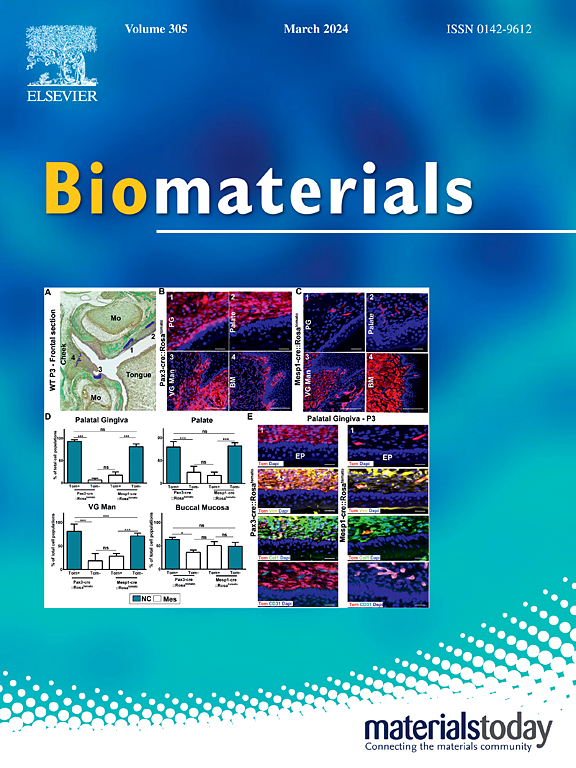Enhanced stem cell-mediated therapeutic immune modulation with zinc oxide nanoparticles in liver regenerative therapy
IF 12.8
1区 医学
Q1 ENGINEERING, BIOMEDICAL
引用次数: 0
Abstract
Liver regenerative therapy is critical for severe liver damage, including acute liver failure, fibrosis, post-cancer resection recovery, and autoimmune liver diseases, where restoration of liver tissues is essential. Stem cell-based therapies hold significant promise in liver regeneration by modulating immune responses to create a favorable healing microenvironment. However, their clinical efficacy has been limited by challenges such as poor cell engraftment and survival within the hostile injury site. To address these limitations, we developed a zinc oxide-derived nanoparticle (PZnONP) that enhances stem cell proliferation and activation by releasing bioactive Zn2+ and reactive oxygen species (ROS). Functionalized PZnONP exhibits pH-responsive behavior and improved dispersibility, enabling a lysosome-specific and sustained release of Zn2+ and ROS. Stem cells labeled with PZnONP (ZnBA) demonstrated anti-inflammatory properties, with paracrine effects influencing macrophages and damaged hepatocytes. In murine models of acute and fibrotic liver injury, it effectively migrated to the liver through stem cell homing effects and promoted anti-inflammatory responses by modulating Treg and Th17 cell polarization, as well as M2 and M1 macrophage balance, while reducing collagen synthesis. This study underscores the potential of integrating stem cell-based therapy with nanomedicine to improve regenerative outcomes in liver disease treatment.

氧化锌纳米颗粒在肝脏再生治疗中增强干细胞介导的治疗性免疫调节
肝再生治疗对严重肝损伤至关重要,包括急性肝衰竭、纤维化、癌症切除后恢复和自身免疫性肝病,其中肝组织的恢复是必不可少的。基于干细胞的治疗通过调节免疫反应来创造有利的愈合微环境,在肝脏再生中具有重要的前景。然而,它们的临床疗效受到诸如细胞植入不良和在敌对损伤部位存活等挑战的限制。为了解决这些限制,我们开发了一种氧化锌衍生的纳米颗粒(PZnONP),它通过释放生物活性Zn2+和活性氧(ROS)来增强干细胞的增殖和激活。功能化的PZnONP表现出ph响应行为和更好的分散性,使溶酶体特异性和持续释放Zn2+和ROS。PZnONP (ZnBA)标记的干细胞显示出抗炎特性,其旁分泌作用影响巨噬细胞和受损肝细胞。在小鼠急性和纤维化肝损伤模型中,它通过干细胞归巢效应有效迁移到肝脏,通过调节Treg和Th17细胞极化以及M2和M1巨噬细胞平衡,促进抗炎反应,同时减少胶原合成。这项研究强调了将干细胞治疗与纳米药物结合起来改善肝脏疾病治疗再生结果的潜力。
本文章由计算机程序翻译,如有差异,请以英文原文为准。
求助全文
约1分钟内获得全文
求助全文
来源期刊

Biomaterials
工程技术-材料科学:生物材料
CiteScore
26.00
自引率
2.90%
发文量
565
审稿时长
46 days
期刊介绍:
Biomaterials is an international journal covering the science and clinical application of biomaterials. A biomaterial is now defined as a substance that has been engineered to take a form which, alone or as part of a complex system, is used to direct, by control of interactions with components of living systems, the course of any therapeutic or diagnostic procedure. It is the aim of the journal to provide a peer-reviewed forum for the publication of original papers and authoritative review and opinion papers dealing with the most important issues facing the use of biomaterials in clinical practice. The scope of the journal covers the wide range of physical, biological and chemical sciences that underpin the design of biomaterials and the clinical disciplines in which they are used. These sciences include polymer synthesis and characterization, drug and gene vector design, the biology of the host response, immunology and toxicology and self assembly at the nanoscale. Clinical applications include the therapies of medical technology and regenerative medicine in all clinical disciplines, and diagnostic systems that reply on innovative contrast and sensing agents. The journal is relevant to areas such as cancer diagnosis and therapy, implantable devices, drug delivery systems, gene vectors, bionanotechnology and tissue engineering.
 求助内容:
求助内容: 应助结果提醒方式:
应助结果提醒方式:


